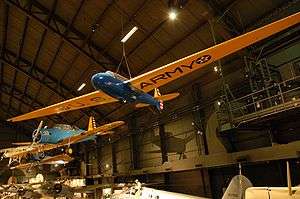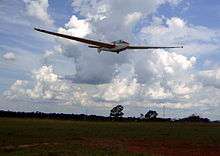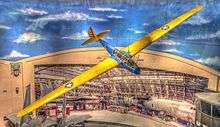Laister-Kauffman TG-4
| TG-4, LK-10 | |
|---|---|
 | |
| TG-4A in the National Museum of the United States Air Force | |
| Role | Sailplane |
| National origin | United States |
| Manufacturer | Laister-Kauffman |
| Designer | Jack Laister |
| Variants | Bartos/Nobel BN-1 Phantom |
The Laister-Kauffman TG-4 (designated LK-10 Yankee Doodle 2 by its designer) was a sailplane produced in the United States during the Second World War for training cargo glider pilots. It was a conventional sailplane design with a fuselage of steel tube construction and wooden wings and tail, skinned all over with fabric. The pilot and instructor sat in tandem under a long canopy.
Design and development
Jack Laister designed the aircraft in response to the formation of the United States Army Air Corps' American Glider Program in 1941, basing it on his Yankee Doodle design of 1938 for Lawrence Tech. Aside from the addition of a second seat, the Yankee Doodle 2 differed from its predecessor by having wings of constant dihedral instead of gull wings. The USAAC expressed interest, but only if Laister could arrange for the manufacture of the type. When Laister found a sponsor in businessman John Kauffman, they established the Laister-Kauffman Corporation in St Louis, Missouri and the USAAC ordered three prototypes as the XTG-4.
When evaluation of the type proved positive, the Army placed an order for 75 aircraft, followed by an order for another 75. These were operated as the TG-4A, along with the original, single-seat Yankee Doodle that was impressed into service. All had been withdrawn from service prior to the end of the war when it was discovered that the flight characteristics of the aircraft were so different to those of a cargo glider, that the experience gained on the TG-4 was not particularly relevant.
Variants
- XTG-4 - prototypes (three built)
- TG-4A - production model (150 built)
- TG-4B - civilian aircraft impressed into service (one impressed)
Operators
LK-10 Serial #106 under prefix PT-PAZ operated by Aeroclube de Bauru in Brazil as of April 2013[1]


Aircraft on display
- 42-43688 – TG-4A on static display at the Planes of Fame in Chino, California.[2][3]
- 42‐43734 – TG-4A on static display at the National Museum of the United States Air Force in Dayton, Ohio.[4][5]
- 42-43740 – TG-4A on static display at the Museum of Aviation at Warner Robins Air Force Base in Warner Robins, Georgia.[6]
- 42-53078 – TG-4A on static display at the Air Mobility Command Museum at Dover Air Force Base near Dover, Delaware.[7]
- 42-530727 – TG-4A on static display at the Silent Wings Museum in Lubbock, Texas.[8][9]
- 28 – TG-4A on static display at the US Southwest Soaring Museum in Moriarty, New Mexico.[10]
- 71 – TG-4A on static display at the Southern Museum of Flight in Birmingham, Alabama.[11]
- 126 – TG-4A on static display at the Military Aviation Museum in Virginia Beach, Virginia.[12]
Specifications (LK-10 / TG-4A)
Data from The World's Sailplanes:Die Segelflugzeuge der Welt:Les Planeurs du Monde Volume II[13]
General characteristics
- Crew: 2
- Length: 21 ft 4 in (6.5 m)
- Wingspan: 50 ft 0 in (15.24 m)
- Height: 3 ft 7.9 in (1.115 m) at cockpit
- Wing area: 164 sq ft (15.2 m2)
- Aspect ratio: 15.1
- Airfoil: root – NACA 4418, tip – NACA 4409
- Empty weight: 476 lb (216 kg) equipped
- Gross weight: 875 lb (397 kg)
Performance
- Stall speed: 38 mph; 33 kn (61 km/h)
- Never exceed speed: 126 mph; 110 kn (203 km/h)
- Rough air speed max: 203 km/h (126.1 mph; 109.6 kn)
- Aerotow speed: 203 km/h (126.1 mph; 109.6 kn)
- Winch launch speed: 130 km/h (80.8 mph; 70.2 kn)
- g limits: +6 -3 at 225 km/h (139.8 mph; 121.5 kn)
- Maximum glide ratio: 22 at 80 km/h (49.7 mph; 43.2 kn)
- Rate of sink: 191 ft/min (0.97 m/s) at 73 km/h (45.4 mph; 39.4 kn)
- Wing loading: 5.4 lb/sq ft (26.5 kg/m2)
See also
Aircraft of comparable role, configuration and era
Related lists
Notes
- ↑ "Planadores: Aeroclube de Bauru" (in Portuguese). 2013. Retrieved 29 Apr 2013.
- ↑ "Flying & Static Aircraft". Planes of Fame Air Museum. Retrieved 30 May 2017.
- ↑ "Airframe Dossier - Laister-KauffmanTG-4, s/n 42-43688 USAAF, c/n 9, c/r N53612". Aerial Visuals. AerialVisuals.ca. Retrieved 30 May 2017.
- ↑ "Laister-Kauffmann TG-4A". National Museum of the US Air Force. 16 April 2015. Retrieved 30 May 2017.
- ↑ "AIRCRAFT, DRONES AND MISSILES AT THE NATIONAL MUSEUM OF THE U.S. AIR FORCE" (PDF). National Museum of the US Air Force. June 2016. Retrieved 30 May 2017.
- ↑ "TG-4A "Yankee Doodle"". Museum of Aviation. Museum of Aviation Foundation, Inc. Retrieved 30 May 2017.
- ↑ "Laister-Kauffman TG-4A". Air Mobility Command Museum. AMC Museum Foundation, Inc. Retrieved 30 May 2017.
- ↑ "Visit The Museum". Silent Wings Museum. City of Lubbock, Texas. Retrieved 30 May 2017.
- ↑ "Airframe Dossier - Laister-KauffmanTG-4, s/n 42-530727 USAAF, c/n 129, c/r N58178". Aerial Visuals. AerialVisuals.ca. Retrieved 30 May 2017.
- ↑ "Sailplanes, Hang Gliders & Motor Gliders". U.S. Southwest Soaring Museum. Retrieved 30 May 2017.
- ↑ "Airframe Dossier - Laister-KauffmanTG-4, c/n 71, c/r N56588". Aerial Visuals. AerialVisuals.ca. Retrieved 30 May 2017.
- ↑ "Aircraft N51462 (1943 Laister-Kauffman LK-10A C/N 126) Photo by Dean Heald (Photo ID: AC292671)". www.airport-data.com. Retrieved 2017-10-31.
- ↑ Shenstone, B.S.; K.G. Wilkinson (1963). The World's Sailplanes:Die Segelflugzeuge der Welt:Les Planeurs du Monde Volume II (in English, French, and German) (1st ed.). Zurich: Organisation Scientifique et Technique Internationale du Vol a Voile (OSTIV) and Schweizer Aero-Revue. pp. 232–233.
References
- Shenstone, B.S.; K.G. Wilkinson (1963). The World's Sailplanes:Die Segelflugzeuge der Welt:Les Planeurs du Monde Volume II (in English, French, and German) (1st ed.). Zurich: Organisation Scientifique et Technique Internationale du Vol a Voile (OSTIV) and Schweizer Aero-Revue. pp. 160–162.
- US Southwest Soaring Museum (2010). "Sailplanes, Hang Gliders & Motor Gliders". Retrieved 26 May 2011.
Further reading
- Taylor, Michael J. H. (1989). Jane's Encyclopedia of Aviation. London: Studio Editions. p. 563.
- Salmi, Reino J. (March 1943). "Gliders for Victory". The Wisconsin Engineer. 47 (6): 8–9. Retrieved 2008-09-16. (uncorrected OCR)
External links
| Wikimedia Commons has media related to Laister-Kauffman TG-4. |